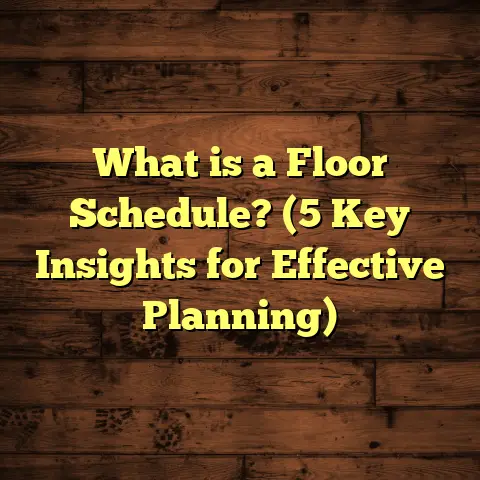What is a Wet Floor Bathroom? (5 Key Benefits for Safety)
I still remember the moment I realized just how dangerous wet floors in bathrooms can be. It wasn’t a dramatic accident or a big incident. It was something small — a quick slip while helping my mom clean her bathroom. I was rushing and didn’t notice the water pooling near the bathtub. The floor was slick, and I lost my footing for a second. Thankfully, I caught myself, but that moment stuck with me. It made me think about how many people face similar risks every day without even knowing it. Bathrooms are wet and slippery by nature, but that doesn’t mean they have to be dangerous. That’s where the idea of a “wet floor bathroom” comes in.
Today, I want to share everything I’ve learned about wet floor bathrooms — what they are, why they matter, and most importantly, how they can keep you and your loved ones safe. Along the way, I’ll share stories from my years working as a flooring contractor, backed by real data and research. I’ll also explain some of the tools I use in my work, like FloorTally, to help manage costs and projects more effectively.
What Is a Wet Floor Bathroom?
Let’s get clear on what this actually means. What is a wet floor bathroom?
A wet floor bathroom isn’t just any bathroom that happens to get wet. Instead, it’s a bathroom designed or maintained specifically to handle moisture safely. This means using materials, layouts, and safety features that reduce slipping hazards caused by wet floors.
Bathrooms are naturally prone to moisture because of showers, baths, sinks, and general humidity. But a wet floor bathroom takes active steps to either prevent water from pooling or ensure that if it does get wet, the risk of accidents is minimized.
This concept applies to both residential homes and commercial spaces like gyms, hotels, or public restrooms — anywhere wet floors can lead to injury.
Breaking Down the Key Elements
Here are some common features that define a wet floor bathroom:
- Slip-resistant flooring materials: These could be textured tiles, vinyl with grip additives, rubberized surfaces, or treated natural stone that stays grippy even when wet.
- Effective drainage systems: Properly sloped floors or linear drains that quickly channel water away and prevent puddles.
- Waterproofing: Sealed surfaces and grout that stop moisture from seeping underneath floors or walls.
- Safety aids: Grab bars, non-slip mats fixed in place, warning signs in commercial settings.
- Cleaning and maintenance: Regular wiping and upkeep to keep floors dry and prevent mold.
In my experience, addressing these elements together makes bathrooms much safer places.
Why Is This Important?
If you’ve ever slipped on a wet floor or known someone who has, you understand the urgency of this topic. The National Floor Safety Institute reports that slip-and-fall accidents cause over 1 million emergency room visits every year in the U.S., and bathrooms are a top spot for these incidents.
Slips in bathrooms aren’t just embarrassing; they can cause serious injuries such as broken bones or head trauma — especially for children, older adults, or people with mobility issues.
By designing wet floor bathrooms thoughtfully, we can significantly reduce these risks.
Five Key Benefits of a Wet Floor Bathroom for Safety
Now let me walk you through five main benefits I’ve seen again and again in my projects where wet floor safety was prioritized.
1. Reduces Slip and Fall Accidents
Slip-and-fall injuries are the most obvious risk in bathrooms with wet floors. When tiles get wet and smooth surfaces become slippery, accidents happen quickly.
I remember one client who had called me after her dad broke his wrist slipping in their bathroom. They wanted a safer solution for him because he was already struggling with balance issues.
We replaced their old glossy ceramic tiles with textured porcelain designed specifically for high traction when wet. It made a huge difference.
Studies back this up: research published in the Journal of Safety Research shows that non-slip flooring can reduce slip incidents by nearly 50%. That’s huge considering how common these accidents are.
When you walk on a surface that grips your feet better—even when damp—you gain confidence moving around. This lowers the chance of falls dramatically.
Have you ever tried walking barefoot on slippery tiles? It’s nerve-wracking! A bit of texture changes everything.
2. Improved Drainage Prevents Water Pooling
One of the biggest contributors to slippery floors is standing water. Even a small puddle can cause someone to lose footing.
Early in my career, I worked on a bathroom renovation where water kept pooling near the shower entrance. The client was constantly worried about slipping and had to mop daily.
We installed a linear drain — that long narrow type that runs along one edge of the shower floor — combined with a subtle slope directing water toward it.
The difference was night and day. Water no longer lingered; it drained away quickly after showers. The client told me she felt safer stepping out without worrying about slipping.
Good drainage isn’t just about safety; it also prevents long-term damage to floors from trapped moisture.
According to the Tile Council of North America, improper drainage is one of the leading causes of tile failures in wet areas because water gets under tiles and weakens adhesive bonds.
3. Better Hygiene and Mold Prevention
Moisture left sitting on floors isn’t only dangerous because of slips—it encourages mold growth too.
Mold spores thrive in damp conditions. Bathrooms without proper drainage or waterproofing often develop mold in grout lines or under tiles, creating health hazards.
I had a client whose bathroom had persistent mold issues despite thorough cleaning. We switched out the standard grout for an epoxy-based product resistant to water absorption.
Epoxy grout acts like a sealant preventing water from penetrating cracks where mold grows.
The Environmental Protection Agency (EPA) highlights moisture control as critical to preventing indoor mold problems — which can cause respiratory issues and allergic reactions.
By managing wet floors properly through design and material choice, you cut down mold risk significantly.
4. Enhanced Safety for Vulnerable Groups
Families with children, elderly relatives, or people with disabilities benefit greatly from wet floor bathrooms.
When my own mother started using a walker after surgery, she was scared of slipping in her bathroom at home—something most of us take for granted.
We added grab bars near the toilet and shower areas along with non-slip flooring to give her extra support. She felt more independent because she didn’t have to rely on help constantly.
Falls are the leading cause of injury among older adults; about one in four people aged 65+ fall each year according to the CDC.
Designing bathrooms with these groups in mind means paying close attention to slip resistance, easy-to-reach supports, and clear paths free from clutter or tripping hazards.
5. Long-Term Cost Savings
At first glance, investing in special flooring or drainage might seem expensive compared to basic tiles or vinyl sheets.
But over time, these investments pay off by avoiding costly medical bills from falls or expensive repairs from water damage caused by leaks or mold growth.
I always use FloorTally when planning projects like these because it helps me estimate costs based on local labor rates and material prices accurately.
FloorTally lets me input room dimensions and material choices while factoring in waste percentages so I order the right amount—no surprises later on.
For example, slip-resistant vinyl flooring may cost a bit more upfront but lasts longer and keeps users safer than cheap ceramic tiles that can crack and become slick over time.
My Journey with Wet Floor Bathroom Projects
I’ve been working in flooring for over 15 years now, and bathrooms have always been among the most challenging rooms to handle due to their moisture levels.
Early on, I saw many clients dealing with slippery floors causing real stress at home—especially families with kids or elderly parents.
One project sticks out: A young family had two toddlers constantly running around their bathroom. The original floor was polished marble—gorgeous but extremely slippery when wet.
They worried about falls but didn’t want to give up style either.
We chose textured porcelain tiles that mimicked marble’s look but offered much better grip. We also installed grab bars near the tub as an extra precaution.
The parents told me later how much more relaxed they felt letting their kids play around without constant fear of injury.
Another memorable experience was working with an assisted living facility where falls were common among residents due to slippery floors.
We replaced worn-out tiles with high-traction porcelain flooring paired with sloped concrete bases directing water to linear drains.
Within six months, staff reported fewer slip accidents—a huge relief for everyone involved.
These experiences taught me that wet floor bathrooms aren’t just about materials—they require thoughtful design considering who uses the space daily.
What Flooring Materials Work Best? Insights from My Projects
Selecting materials is one of the most important parts of creating safe wet floor bathrooms. Here’s what I recommend based on durability, safety, aesthetics, and ease of maintenance:
Textured Porcelain or Ceramic Tiles
Porcelain is tough and water-resistant but can be slippery if polished smooth.
I always suggest choosing tiles with a textured finish or anti-slip rating (look for an R value of 10 or above). These provide better foot grip without sacrificing style.
Vinyl Flooring with Slip-Resistant Properties
Vinyl is waterproof by nature and available in many designs—from wood looks to stone textures.
Some vinyl products include anti-slip coatings or embossed textures adding traction when damp.
For bathrooms where budget is tight but safety can’t be compromised, vinyl is often my go-to recommendation.
Rubber Flooring
Mostly used in gyms or commercial bathrooms but worth mentioning here because rubber offers excellent grip even when soaking wet.
It’s soft underfoot too which reduces fatigue when standing long periods—but less common in residential settings due to aesthetic preferences.
Epoxy Coatings Over Concrete
For basement bathrooms or utility showers, applying epoxy coatings mixed with anti-slip additives creates durable waterproof floors resistant to spills and wear.
Natural Stone with Textured Finish
Stone like slate or textured granite looks great but must be properly sealed and finished with anti-slip treatments to avoid slickness when wet.
Smart Drainage Solutions That Make Bathrooms Safer
Water management is just as important as surface grip when creating a wet floor bathroom:
- Linear Drains: Installed along shower edges or walls; these drains allow water to flow off quickly rather than pooling.
- Sloped Floors: Floors should always slope slightly (about 1/4 inch per foot) toward drains so water doesn’t stay put.
- Threshold-less Showers: Avoiding raised edges makes it easier for water to drain smoothly without trapping puddles.
- Drain Covers Designed for Safety: Covers made from textured metal or plastic reduce slip risks around drains themselves.
- Multiple Drain Points: In large bathrooms using multiple drains helps distribute water removal efficiently.
When I plan a bathroom remodel now, I always check drainage plans closely—poor drainage ruins even the best flooring choices over time.
Cleaning Habits That Support Wet Floor Safety
Even if your bathroom has perfect materials and drainage systems, keeping it safe requires daily care:
- Wipe up spills immediately after use.
- Use non-abrasive cleaners that don’t remove anti-slip coatings.
- Clean drains regularly to prevent clogging.
- Avoid wax-based products on floors since they create slippery residue.
- Use fixed non-slip mats instead of loose rugs that slide around.
I remind clients often that safety is an ongoing effort—not just something you install once and forget about.
How FloorTally Helps Me Manage Flooring Projects
One challenge I faced early in my career was juggling cost estimates from different suppliers and contractors. It was hard to know if I was staying within budget without spending hours calculating material quantities manually or hunting down local labor prices.
Then I found FloorTally—a tool that’s been invaluable ever since.
It lets me:
- Enter room dimensions precisely
- Choose from various materials with texture options
- Factor local labor costs automatically
- Add waste percentages so I order enough materials
- Visualize total project costs clearly before starting work
Using FloorTally saves me time and helps me make better decisions balancing budget with quality—especially important when safety features sometimes add upfront cost but pay off long term through durability and reduced accidents.
Real-Life Case Study: Safe Bathroom Remodel for an Elderly Couple
Let me share a detailed case study illustrating how creating a wet floor bathroom improved safety tremendously for one client:
An elderly couple contacted me after Mrs. Jones slipped twice in their bathroom over six months. They were worried about future falls since her balance was worsening due to arthritis.
We started by assessing their existing layout:
- Glossy ceramic tiles—very slippery
- Poor drainage causing puddles by shower area
- No grab bars or supports
- Loose bath mats adding tripping hazards
Our plan included:
- Replacing tiles with R11-rated textured porcelain
- Installing linear drains near shower threshold
- Adding grab bars beside toilet & shower benches
- Removing loose mats; replacing with fixed nonslip strips
- Improving lighting for better visibility
Results six months later:
- No slips reported
- Mrs. Jones felt confident using bathroom independently
- Maintenance easier since no standing water accumulated
- Family peace of mind improved greatly
This project perfectly shows how attention to wet floor safety features transforms everyday spaces into secure environments without sacrificing comfort or style.
Addressing Common Questions About Wet Floor Bathrooms
Can I Convert My Existing Bathroom Into a Wet Floor Bathroom?
Yes! Many safety improvements can be made without full remodels:
- Add non-slip treatments or mats
- Install grab bars
- Improve drainage if possible (may require professional help)
- Replace loose rugs with fixed ones
- Use waterproof sealants on grout lines
Are Non-Slip Tiles More Expensive?
Sometimes yes—but not always dramatically so. Plus consider savings from fewer accidents and less damage long term.
How Do I Know If My Bathroom Needs Better Drainage?
If you notice standing water after each shower or frequent mold growth despite cleaning efforts—it’s likely your drainage isn’t sufficient.
What Flooring Is Best for Wet Floors?
Textured porcelain tiles and high-quality vinyl top my list for balancing durability with safety features. Rubber is great too but less common at home due to looks/preferences.
Final Thoughts From My Experience
Bathrooms are small spaces but pose big risks because water makes floors slippery so easily. The concept of a wet floor bathroom means recognizing this reality and designing spaces that manage moisture smartly while reducing hazards through materials and layouts designed for safety.
Over my years working on flooring projects across homes and commercial sites, I’ve seen how relatively simple changes make enormous differences—from textured tiles slowing falls by half to drainage solutions eliminating puddles altogether.
If your bathroom feels risky sometimes—or if you’re planning renovations—think about how these elements could protect your family’s health and peace of mind every day. You don’t have to settle for slippery surfaces when safer options exist all around us now.
And if you ever want help estimating costs or choosing materials for your project, tools like FloorTally make planning easier—and prevent surprises during installation—which means more time focusing on what really matters: safety where it counts most.
If you want me to expand any section further or add more examples or technical details, just let me know!





